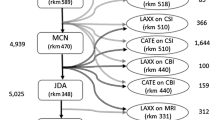Abstract
A certain number of tagged fish is liberated and assumed to be distributed randomly among a natural fish population. The fish are subjected to a number of fishing experiments within relatively short periods, and lie between equal intervening periods of durationT. Untagged fish are retained, while tagged fish are released during the fishing experiments. Denoting the catchability of untagged fish byq u and that for tagged fish byq t , it is assumed that they are related by the equation “q u =cq t ” wherec is a constant. Denoting the survival rates of tagged fish and the effective fishing effort of commerical fisheries per unit time from the (k-1)th to thek th experiments by t S k andf k , respectively, it is assumed that they vary from period to period. Assuming that during thek th experiment, the number of untagged fish captured and the experimental fishing rate of tagged fish are denoted by u X k and t P k , respectively, then
The above equation containsc as a single unknown, while all other terms are supplied by the capture-recapture experiments, exceptf k andf (k+1) which may be obtained from fisheries statistics. A number of the above equations are obtained from several experiments and can be combined into a single equation to obtain an overall estimate forc which can be used to derive estimates for experimental fishing rates, abundance, and instantaneous natural and fishing mortality rates for natural fish populations. These estimates are free from type (A) tagging errors, and have the advantage of taking into consideration the probable different behaviour of tagged and untagged fish.
Similar content being viewed by others

Literature cited
Baily, N. T. J.: On estimating the size of mobile populations from recapture data. Biometrika38, 293–306 (1951).
Baranov, F. I.: On the question of the biological basis of fisheries. Nauch. issled. ikhtiol. Inst. Izv.1 (1), 81–128 (1918).
Beverton, R. J. H. andS. Holt: On the dynamics of exploited fish populations. Fish. Invest., Lond. (Ser. 2)19, 1–533 (1957).
Darroch, J. N.: The multiple recapture census, I-Estimation of a closed population. Biometrika45, 343–359 (1958).
—: The multiple-recapture census. II-Estimation when there is immigration or death. Biometrika46, 336–351 (1959).
Hammersley, J. M.: Capture-recapture analysis. Biometrika40, 137–169 (1953).
Rafail, S. Z.: Estimation of abundance of fish populations by capture-recapture experiments. Mar. Biol.10, 1–7 (1971).
Ricker, W. E.: Further notes on fishing mortality and effort. Copeia1, 23–44 (1944).
—: Handbook of computations for biological statistics of fish populations. Bull. Fish. Res. Bd Can.119, 1–300 (1958).
Robson, D. S.: Maximum likelihood estimation of a sequence of annual survival rates from capture-recapture series. ICNAF Spec. Publs4, 330–335 (1963).
Author information
Authors and Affiliations
Additional information
Communicated byO. Kinne, Hamburg
Rights and permissions
About this article
Cite this article
Rafail, S.Z. Estimation of some parameters of large fish populations by capture-recapture experiments. Mar. Biol. 10, 8–12 (1971). https://doi.org/10.1007/BF02026760
Accepted:
Issue Date:
DOI: https://doi.org/10.1007/BF02026760



